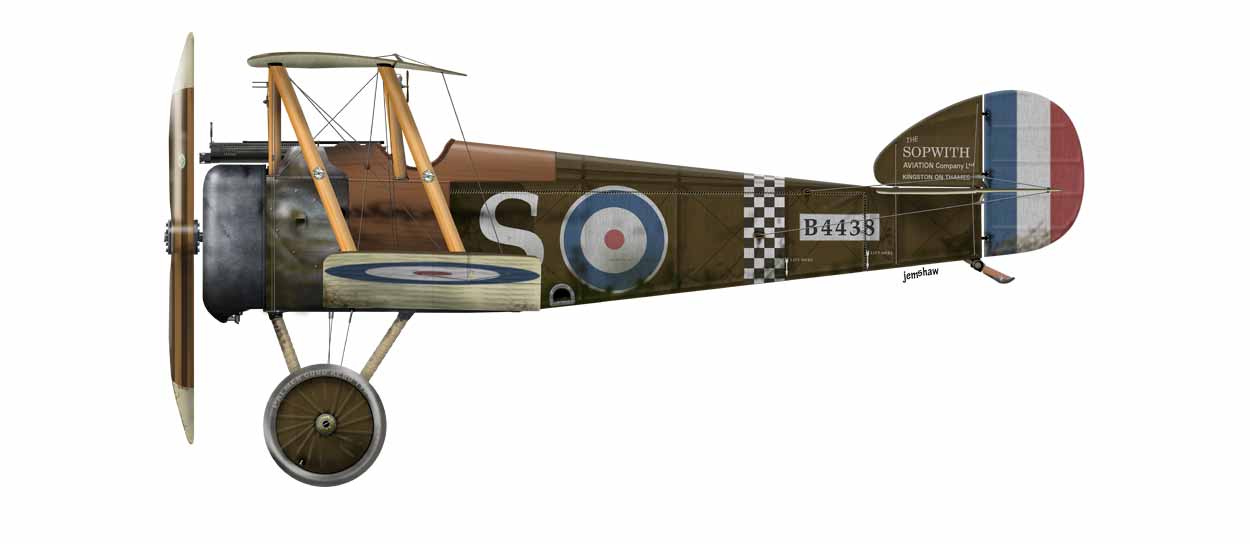| | | The Larks | | | All This Way for a Shilling | | | Yellow Impi | | | Back Burner | | | Other Nonsense | | | About Me |



Sopwith Camel (1916)
Mad, Bad and Dangerous to Know
I make no apology for borrowing Lady Caroline Lamb's description of Lord Byron. In the wrong hands, the Camel was as dangerous to its pilots as it was to its enemy. Albert Ball hated it, preferring the speed and predictability of its contemporary, the R.A.F. SE5a. Yet this pocket-sized bundle of ill-temper accounted for more enemy kills than any other Allied type. It wasn't fast, but its manouevrability - in one direction at least - was such that it could buck out of a pursuer's sights and turn up on the enemy's tail in less time than it takes to shout "Scheisse!".The aircraft's name was, like its predecessor the Pup, unofficial. During development, it was known as the "Big Pup" (despite being slightly shorter). It was the pronounced hump over the breeches of the twin Vickers machine guns that gave rise to its being christened "Camel", though Sopwith never acknowledged the name.
The Camel's bizarre handling was a result of mounting a rotary engine, two machine guns and a pilot within the front six feet of the airframe. In a rotary, rather than the crankshaft rotating in a stationary casing, the crank stays still and the whole engine rotates around it. 170kg of metal spinning at over 1,000 revs per minute produces a great deal of gyroscopic force!
This is why the Camel's nimbleness was somewhat asymmettrical. When turning left, gyroscopic precession caused the nose to rise, with the secondary effect of resisting a bank to port. When turning right, the nose would drop, accompanied by an enthusiastic dipping of the right wing. Get it wrong and a spin was an inevitability for which many pilots paid with their lives. But in skilled hands, this violent right turn was the Camel's greatest weapon. It could duck out of any enemy's firing line, and appear in a killing position on his tail in seconds. The difference in right and left turning performance was so profound that a Camel could perform a 360° turn to the right faster than a 90° turn to the left.
Although the Camel flew for the first time in December 1916, the first production order wasn't produced by the War Office until May 1917, with the first models being issued in June. Alongside the faster but less nimble R.A.F. S.E.5, it established allied air superiority and helped maintain it until still more advanced machines like the Sopwith Dolphin entered the theatre to balance Germany's formidable Fokker D.VII.
General |
|
| Country of origin: | Great Britain |
| Crew: | 1 |
| Purpose: | fighter |
| Powerplant: | 1 × Clerget 9B 9-cylinder air-cooled rotary piston engine, 130 hp (97 kW) |
| Armament: | 2 × 0.303 in (7.70 mm) Vickers machine guns |
Performance |
|
| Maximum speed: | 182km/h (113 mph) |
| Maximum ceiling: | 5,800m (19,000 ft) |
| Range: | 480km (300 miles) |
Dimensions |
|
| Wingspan: | 8.5m (28ft) |
| Length: | 5.7m (18ft 9in) |
| Height: | 2.6m (8ft 6 in) |
| Weight: | 422kg (930lb) |
Figures from Wikipedia
My Picture
The legendary Camel makes its appearance later on in The Larks, finding favour with its pilots thanks to its firepower and mutinous agility. I've not kept track of the picture's production hours, but I think it may have broken the record previously held by the F.E.2b. I've chosen Humphrey Page's machine as my subject as I wanted one with some identifying mark. The chequered band is Page's tribute to his friend, Arthur French.
Pages
Copyright © 2016-2024, Jem Shaw

